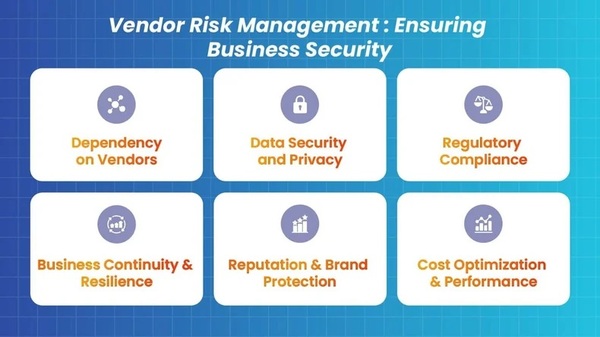ALL BUSINESS
COMIDA
DIRECTORIES
ENTERTAINMENT
FINER THINGS
FREE CREATOR TOOLS
HEALTH
MARKETPLACE
MEMBER's ONLY
MONEY MATTER$
MOTIVATIONAL
NEWS & WEATHER
TECHNOLOGIA
TV NETWORKS
VIDEOS
VOTE USA 2026/2028
INVESTOR RELATIONS
ALL BUSINESS
COMIDA
DIRECTORIES
ENTERTAINMENT
FINER THINGS
FREE CREATOR TOOLS
HEALTH
MARKETPLACE
MEMBER's ONLY
MONEY MATTER$
MOTIVATIONAL
NEWS & WEATHER
TECHNOLOGIA
TV NETWORKS
VIDEOS
VOTE USA 2026/2028
INVESTOR RELATIONS
 Barbara Schwarz -
3 hours ago -
Business -
19 views -
0 Comments -
0 Likes -
0 Reviews
Barbara Schwarz -
3 hours ago -
Business -
19 views -
0 Comments -
0 Likes -
0 Reviews

Technology collaborations often extend over five to seven years, during which the risk landscape can shift significantly. To address emerging threats, regulatory updates, and potential vendor performance issues, insurers need a well-structured third-party risk management framework that ensures continuous monitoring and protection.
The Significance of a Vendor Risk Management Framework
A vendor risk management (VRM) framework forms the backbone of a robust VRM program. It outlines the policies, procedures, and best practices required to manage third-party risks efficiently. Without a strong framework, organizations may face inefficiencies, inconsistencies, and missed opportunities to mitigate security threats.
Consider a vendor security assessment framework as the blueprint of a structure—it defines the organization and ensures that essential components like risk assessments, vendor oversight, and incident response work in harmony. A structured approach helps organizations recognize potential risks, analyze their impact, and implement effective mitigation strategies. Without a clear framework, insurers may adopt reactive measures, leaving them vulnerable to security breaches and compliance failures.
Regulatory Considerations for Vendor Risk Management in the Insurance Industry
The U.S. insurance sector operates under strict federal and state regulations, which extend to third-party vendors. These regulations define compliance requirements to maintain data security, operational integrity, and regulatory adherence. Key regulatory frameworks include:
Insurance Data Security Model Law: Created by the National Association of Insurance Commissioners (NAIC) and adopted by several states, this law mandates insurers to implement stringent security protocols to manage third-party risks effectively.
Office of the Comptroller of the Currency (OCC): Though primarily overseeing national banks, the OCC's risk management guidelines are widely utilized by insurers to enhance third-party risk oversight.
Federal Financial Institutions Examination Council (FFIEC): The FFIEC sets standardized IT security, risk management, and vendor oversight requirements for financial institutions, including insurance companies. Compliance with these standards is essential, particularly for firms utilizing cloud-based platforms.
Consumer Financial Protection Bureau (CFPB): The CFPB regulates financial products and services, including those in the insurance sector. Compliance ensures transparency and fairness in customer interactions, especially concerning third-party vendors.
Beyond federal mandates, insurers must also comply with state-specific reporting and audit obligations. Each state’s insurance regulatory body may enforce distinct requirements, including periodic assessments of third-party service providers, financial health reporting, and adherence to risk management protocols. Regular risk evaluations of vendor partnerships are frequently mandated as part of these compliance measures.
By adopting a comprehensive vendor risk management strategy, insurers can not only ensure regulatory compliance but also strengthen their cybersecurity measures, reduce financial exposure, and enhance operational stability in a rapidly evolving risk environment.

